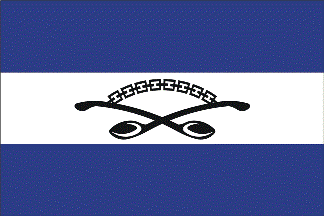 image
by Martin Grieve, 16 Dec 2006
image
by Martin Grieve, 16 Dec 2006

Last modified: 2009-10-17 by bruce berry
Keywords: south africa | homeland | gazankulu |
Links: FOTW homepage |
search |
disclaimer and copyright |
write us |
mirrors
 image
by Martin Grieve, 16 Dec 2006
image
by Martin Grieve, 16 Dec 2006
One main part and one smaller enclave in north eastern
Transvaal
(today's Limpopo Province), extensively bordering
on Venda and briefly Lebowa and
KaNgwane.
Antonio Martins, 30 May 1999
The name Gazankulu is derived from Lake Gaza and Gazaland in nearby
Mozambique. The Shangaan people living in the area are closely related
to the Tsonga who live in Mozambique. Originally Gazankulu was named Machangana,
for its Shangaan inhabitants. Gazankulu was granted internal self-government
on 01 February 1973.
Bruce Berry, 01 Dec1998
The name Shangaan is used of the Tsonga of the former Gazankulu because
one of the kings who ruled the state (formed by Nguni-speaking exiles from
the area later called Zululand) was Shoshangane. Although the Gaza kingdom
was ruled by abeNguni, it never adopted the isiNguni language, instead
retaining its Tsonga tongue (which was nonetheless heavily influenced by
isiNguni). The term Tsonga is, strictly speaking, the correct one to use
for this people, whether in South Africa or in Mozambique. I believe the
name Shangaan (or its Portuguese equivalent) is used on either side of
the border - the spelling Machangana indicates a Portuguese origin, since
the combination CH in Portuguese has the same sound as SH in English.
Mike Oettle, 30 Jan 2002
The design of the Gazankulu flag is set out in section 2 of the Gazankulu
Flag Act of 1973, which reads as follows:
"The Gazankulu Flag shall be a flag consisting of three horizontal
stripes of equal width from top to bottom blue, white and blue, on which
there shall appear, in the centre of the white stripe, two traditional
black wooden spoons in saltire with the handles sloping backwards and connected
archwise by means of a black chain consisting of 15 links.
The width of the Gazankulu flag shall be equal to two-thirds of its
length.
The length of each of the black spoons shall be equal to two-thirds
of the width of the flag".
The blue panels are said to symbolise the infinity of the sky and,
like the sky, that there should be no limit to advancement and development.
The choice of black and white in the central panel alludes to the co-operation
between the black and white people in the territory. The spoons joined
by a chain are in actual use by the Shangaan people during traditional
ceremonies. Being carved out of a single block of wood, the spoons cannot
be separated and harmony must prevail between two people wishing to eat
with them. Their appearance is a signal that disputes must be settled and
hospitality offered to strangers.
The date of commencement of this Act was 18 December 1973. It was amended
in 1986 by means of the Gazankulu Flag Amendment Act which provided for
penalties in respect of the defacement, damage, destruction of, or contempt
for the flag of Gazankulu.
Gazankulu was a "self-governing" territory within South Africa and
the Gazankulu flag was flown alongside the South African national flag
until the homeland was re-incorporated into South Africa on 27 April 1994.
The area is now part of the Limpopo Province. The Gazankulu flag is
no longer in use.
Bruce Berry, 01 Dec1998
gz.gif) scan by
Bruce Berry, 07 July 2007
scan by
Bruce Berry, 07 July 2007
By Government Notice No. 1599, published in the South African Government Gazette (Number 3644 of 08 September 1972), it was notified that a coat of arms had been registered for the Gazankulu Legislative Assembly in terms of the South African Heraldry Act (Act No. 18 of 1962). Although application and registration was made in terms of the Heraldry Act (Government Notice 1599 in Government Gazette 3644 of 08 September 1972), the State Herald did not issue a formal certificate of registration in respect of these Arms as they had been devised without consultation of the Bureau of Heraldry.
The blazon of the coat of arms is described as:
Arms:
An oval shield, per fess wavy, in chief Azure, two spoons in
saltire, handles upwards and joined embowed Chain Or, in base per pale Argent
and sable, dexter two cogwheels conjoined in pale sable, sinister a flame Or;
over all ten pairs of spear thong apertures in pale Argent.
Crest: On a wreath Argent and sable, a lion passant guardant Gules
holding in the dexter forepaw a horn erect, Or.
Supporters: Dexter a buffalo and sinister a sable antelope proper.
Compartment: Vert, semé of succulents proper
Motto: MINTIRHO YA VULAVULA (Deeds Count)
With the
re-incorporation of Gazankulu into South Africa on 27 April 1994, these arms are
no longer in use.
Bruce Berry, 07 July 2007